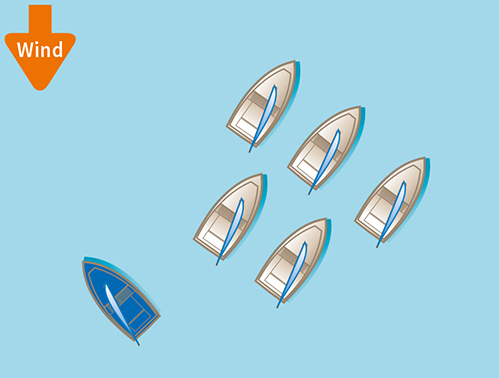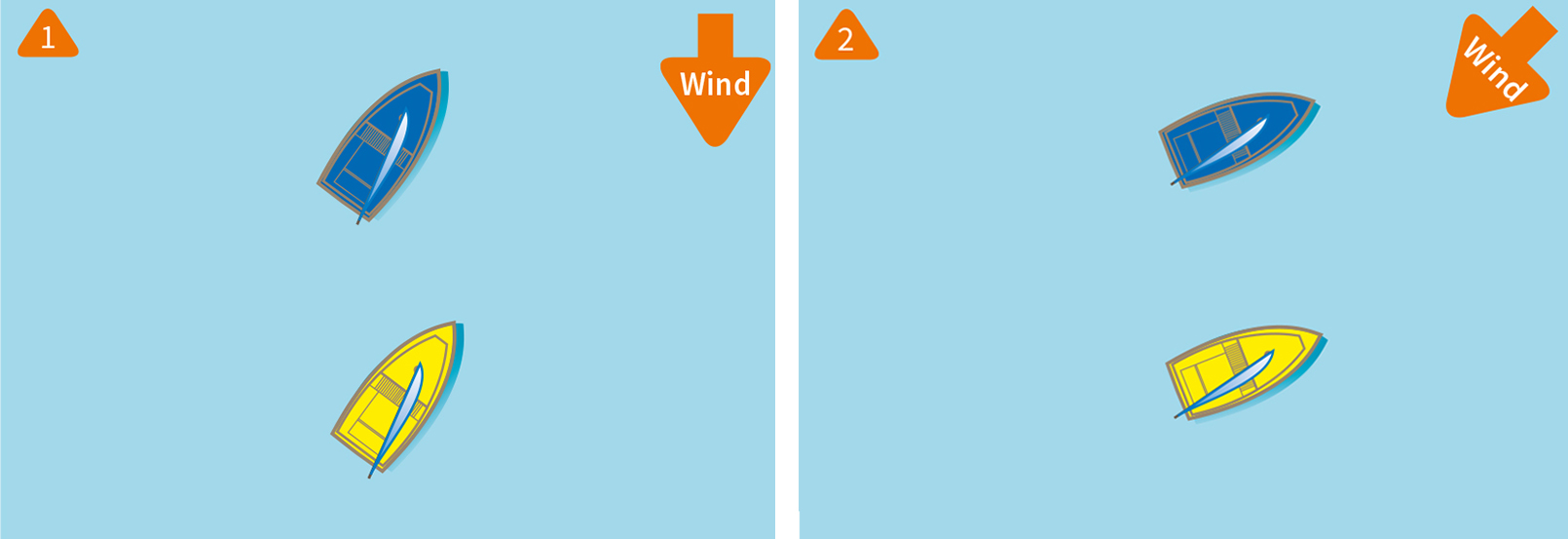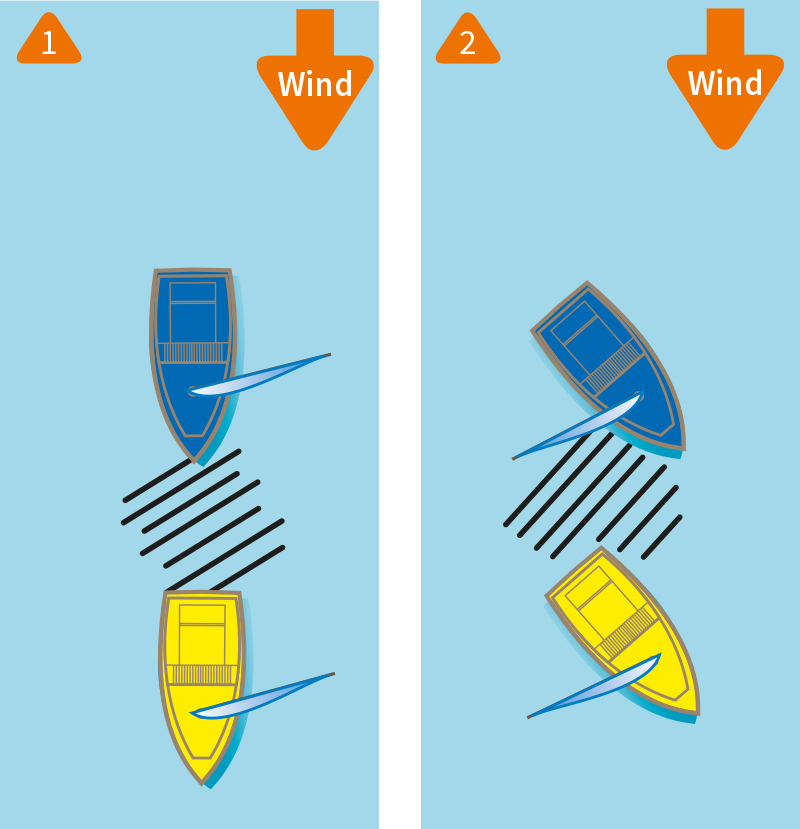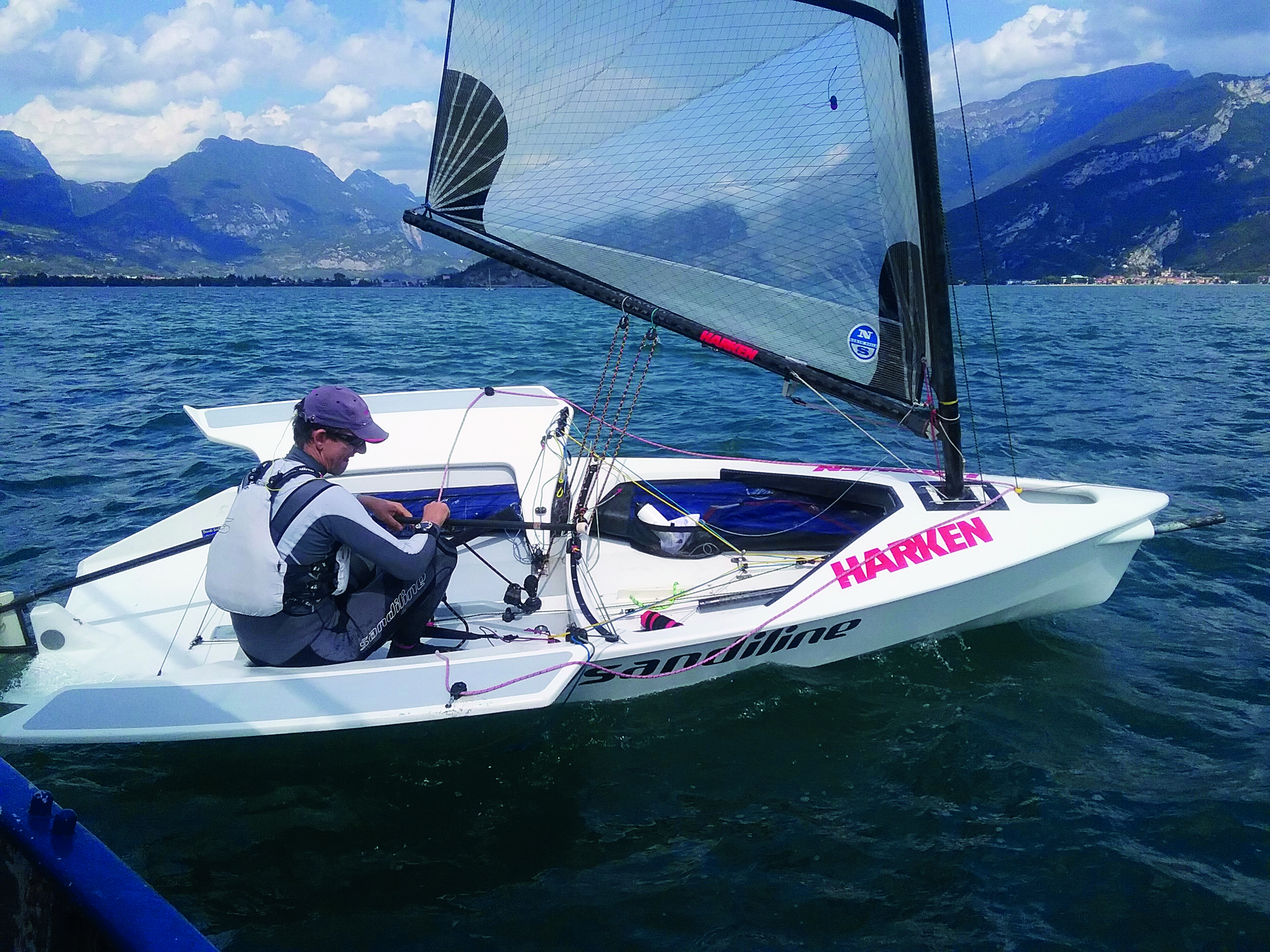BOAT-ON-BOAT TACTICS
Knowing your opposition is important. Some sailors are relatively passive and some more aggressive. You can be more confident of overtaking moves working against passive opponents so you should be more ready to try an overtaking move. With an aggressive opponent, you need to ensure that you have a clear overtaking opportunity before making a move or you are likely to end up wasting distance through a luffing match or similar. You should also leave a bit more space to avoid an unnecessary incident.
UPWIND
Attacking
If you are sailing in a pack or group of boats, you should aim to find shifts or pressure that move you into anti-phase with the pack around you so you are sailing in clearer pressure. Other boats’ sails generate a lot of dirty wind and wind likes to bend past obstacles. So you will advance even if the shifts / pressure you take are average because you will have clearer air than the other boats. On the sea, splitting will mean you sail in more consistent waves which are easier to steer in an effective rhythm.
|

Try to get in a different phase to the boats around you
|
If it is late in the race and you have a few boats to potentially attack with no risk of being overtaken, you should throw in lots of tacks or gybes in the hope of forcing an error from your opposition. Good boat handling helps. If you are very close to your opponent, but they are covering well, you can try a dummy tack to split with them whilst on a good windshift / pressure.
You should aim simultaneously to attack and defend by loose covering the boats behind whilst splitting with those in front, ideally on a decent shift or pressure.
You should seek to leverage starboard advantage. To overtake someone on port you need to be a boat length clear. To catch another boat up on starboard, you only need to be within a boat length. So planning your final approach on starboard can be almost a 2-boat-length gain in tactical advantage. In close situations, or late in a leg, you should aim to get on the right-hand side of your opponent so that you end up with the starboard tack advantage. As ever, picking a good shift or decent pressure is a more effective way to overtake than this.
When attacking, you can ‘put the hammer down’ in moderate or windy weather to find an extra burst of speed just when it is needed (e.g. a marginal leebow), trying to roll someone to force them to tack. You should hike and work the sails extra hard for perhaps a 10 second burst. This work rate will be harder than your opposition unless they are doing the same thing at the same time, which is rare. Of course, you should use this tool judiciously as you don’t want to end up drained for the rest of the race.
The leebow tack can be a very powerful tool when things get close. The real power of the move is forcing your opponent to tack onto the unfavoured tack. Being in phase with the shifts and pressure is vital for that so you know when it is right to go for a leebow tack and when it is better to take a duck.

- As you approach an opponent what do you do?
- If you are expecting a lift, stay on port (the favoured tack), ducking if necessary
- But if you are expecting a header, you should leebow on starboard (the favoured tack) and hopefully force your opponent off on port (the unfavoured tack)
How close you can legally tack to another boat’s leebow varies greatly by boat (e.g. an Enterprise tacks very quickly so you can tuck in close to an opponent). However, a leebow tack is very hard to pull off in a B14 which has wings, moves fast through the water and is slow to tack. Close-quarter 2-boat tuning is a great way to learn where the ‘point of death’ is with a leebow (i.e. the place where you can no longer live with being leebowed and you quickly slow up or slip sideways).
The leebow position varies significantly by class. The leebow position is when you kill the lane for the windward boat so they either slip to leeward into your wind shadow completely or can only stay to windward of you through excessive pinching, resulting in a loss of speed.
The leebow effect works via the wind exiting your sails at a tighter angle than they enter your sails as your sails work as an aerofoil. This angle change varies by boat so the effectiveness of a leebow tack varies by boat. Also, some boats can handle a leebow situation better than others depending on how well the rigs eat dirt and how well the foils work. So, for example: a Merlin Rocket is very hard to leebow; an OK relatively easy.
Consolidating
To consolidate your position, you should continue to sail for shifts and pressure but keep an eye on your opposition. So you may sail through a shift (i.e. not tack on what you think is a header), if that keep you in touch with your opposition

If yellow decides not to tack on a header you may also choose not to and stay with him
If the wind is shifty and unstable, spending too much time looking at the opposition and following their track will cause you to lose phase with windshifts and pressure. In these conditions, your cover needs to be looser and you need to be less distracted by the fleet or your attempt to consolidate will result in place losses.
In steadier wind, you can afford to cover harder and watch the fleet more to ensure that you consolidate your position.
As this cover becomes more instinctive, the difference between your attack and consolidate mode can reduce which makes both modes more effective. So ideally, you can continue to attack shifts and pressure effectively whilst also keeping half an eye on where the fleet is.
Defending
How hard you defend a position depends on how far advanced the race is, how the fleet is distributed and where you are versus your outcome objectives.
Progression of race: Early in a race, defending hard would be a gamble except in extreme circumstances (e.g. you just need to stop one opponent to win a championship). Defending hard early in a race could result in place losses that you are unable to make up. At this stage the fleet is much more tightly compacted so any distance loss from being involved with other boats can result in a lot of places lost. Therefore, you should usually focus on your own race early in the race and avoid boat-on-boat tactical battles.
Fleet distribution: If there is a big gap in front of you and a big gap after the boat you are defending against, a hard defence may make sense as you aren’t potentially foregoing place gains or risking place losses. This works the other way – hard attack can be appropriate if there is a big gap behind you and lots of opportunity for gain ahead.
Status vs. outcome objective: If you are ahead of your objectives and this place is key you may choose to defend hard. If you are behind your objectives, you should probably be attacking the race rather than defending.
Defending hard upwind means staying between your opposition and the windward mark and sitting on their wind to ensure that they receive dirty wind so slowing them up.
However, it can be appropriate to increase the gap on the boat behind (e.g. you are about to head onto a downwind leg to the finish where an increased gap greatly reduces your vulnerability to attack). In this case you need to stop defending and start attacking.
If your opponent is getting very close to you and may slip by, things may get too close to keep defending hard and, again, attack may be your best option.
At the 1989 Bloody Mary (yes, it appears that I am old!), we were lying 3rd up the final beat in a Cadet with Rob Larke very close behind us. There was no scope for place gains. So we covered Rob hard. Rob overtook us because he stayed in phase with the shifts whilst we tried to cover. It did not work as we were always out of phase with the shifts and got sucked backwards. An early lesson on when to stop defending hard!
In these circumstances, you should aim to move back into attack mode, working the shifts and pressure to stay ahead and, if possible, protect the right-hand side. If things are close, the starboard boat has right of way. However, you should be fluid on this. If left is paying heavily, you should protect left.
REACHES
Attacking
On the reach, attacking to windward is typically the fastest way to gain places.
The exceptions to this are on a very broad leg or late on the first reach, when it can often pay to attack an opponent to leeward as you approach the gybe mark. To overtake your opponent to leeward, you just need an overlap whereas to overtake to windward you need to break clear ahead. So overtaking to leeward is a boat length easier than overtaking to windward as you approach the mark rounding.
However, gaining and holding an overlap is much harder on a tighter angle as you will be trying to hold that overlap in dirty air. So, on a tight reach, you should usually aim to overtake to windward.
Nevertheless, late in the leg, it can pay to seek an inside overlap rather than trying to pass to windward. With good timing you can establish an overlap to leeward fairly late and aim to just hold it for the few boat lengths into the mark.
If there is no issue with losing some distance (e.g. big gap on the boat behind and you don’t need to catch the boats in front to achieve your outcome objectives) and you don’t think you will manage a windward pass, you should aim to overlap to leeward early and take your opponent as high as is legitimate.
As leeward boat, you are entitled to sail your proper course. A high route can be justified if there is more wind or better waves to windward. An expected upcoming windshift may also justify sailing high. By sailing yourself and your opponent high, the final approach to the gybe mark will be broader which increases your chances of gaining water.

- If you can’t overtake to windward, but there is a reason to sail high (e.g. better waves), establish an overlap to leeward
- And sail your proper course to the waves, forcing yellow high
- Then you will have to run down to the mark, and it is much easier to attack and get room at the mark
Consolidating
To consolidate your position, you should protect your windward side, so you aren’t rolled, but dive low towards the rhumb line when there aren’t boats attacking you to windward.
How hard you protect to windward depends on how tight the reach is and how much boats to windward slow you in your particular class. They always do, but how much varies (e.g. in a Merlin Rocket losing your lane to windward on anything but a very broad reach is death; in a single-hander in waves, the cost is low if you still have just enough space to keep working the waves effectively).
Defending
The best defence is usually to hold a high lane. Whilst this is effective in stopping boats overtaking, it can result in distance losses to those ahead and add to the first reach ‘banana’. So ideally, you will defend your lane while going high by as little as you can get away with.
To defend against someone trying to establish a late, leeward inside overlap (see above), you should push as low as possible late in the leg.
SYMMETRIC RUNS
Attacking
To attack one boat, you should aim to blanket their wind. This makes playing the spinnaker for your opponent hard as the wind is disturbed. The wind for your opponent is also slowed so you will quickly close up. This is an aggressive tactic so should be deployed judiciously.
To escape your dirty wind, your opponent has to sail more distance than you, so you gain every time they try to escape your dirt. Your opponent may try to gybe. You should look for the signs of that (e.g. crew getting ready to release poles, tiller extension going behind the helm etc.). That will enable you to anticipate their move and stick on their wind.
If you time your gybes and steering back on to your opponent’s dirty wind with windshifts and greater pressure you can make further gains.

- If you are covering your opposition, they will look for ways to get clear wind
- If they gybe, gybe with them and ensure you are still blanketing them
In a tight boat-on-boat situation, a double gybe is a punchy move but a great way to gain luffing rights. If you double gybe, you are on a new gybe, so you regain luffing rights until the windward boat has managed to break clear ahead again. A double gybe can be pulled off very quickly with a small turn and a flick of the boom across your head.
Consolidating
This is a hard leg to consolidate on. Similarly, to any other run, you are looking to sail fast in the right direction whilst keeping clear air and managing risk. These goals are often incompatible. It is usually better to keep clear air via a little separation from the fleet so taking some can reduce risk rather than sit in dirty air in the pack.
Defence
To defend against a boat attacking you directly, you should seek to keep sailing fast in pressure and favourable shifts. If you find a shift or pressure to escape the cover whilst not sailing too much extra distance, then take these opportunities. The best defence is not being in your opponent’s dirty air so slightly forward or back from that depending on which side of the course is critical to defend.
|

To defend against attack, try to position
yourself slightly away from their wind shadow
|
If someone is really intent on sitting on your wind, they will gain and catch you eventually. However, defending against someone really keen on overtaking you is possible. With appropriate defence, you should become very hard to overtake but you will lose distance in your defence. So you need to balance up how important this one place is to you versus managing the fleet. This depends on your position versus your outcome goals, how your opponent affects your goals and how advanced the race is.
To defend early / mid-way down the run, protect the favoured side of the course. So it is important to have a good idea which side is favoured. Later in the run, protect your inside overlap.
In race 6 of the 2017 Merlin Rocket Nationals, we led at the last windward mark by a few boat lengths from Andy ‘Taxi’ Davis & Alex Warren with just a run to the finish. We put ourselves between Taxi & Alex and the leeward mark and they gradually closed us in by smothering our wind (and sailing the waves well!). In hindsight, we should have put on a loose cover, positioning ourselves slightly more out to sea than a tight cover to take advantage of the nicer waves out there. Our tight cover allowed Taxi & Alex to close level with us going into the finish. We aimed to sail them past the starboard layline in order to give them dirty wind and stay ahead even if they got their noses out. On the last wave before performing our winning move they caught a lovely (for them) wave, gained a length and gybed round the front of us. A tight cover on a run should only be performed late in the race with a decent lead, not from the start of the run with a few lengths’ lead.
ASYMMETRIC RUNS
Attacking
As for upwind, you will sail fastest when you have your head out of the boat and are attacking every gust and shift. This is potentially risky as such intense focus on pressure and shifts means that you can lose sight of the fleet and so take risks. A good crew can help massively in observing the other boats and feeding the helm relevant information. Developing the skill of attacking the race whilst still being able to keep half an eye on the fleet also helps.
Consolidating
You should continue to attack the pressure and shifts, or you will be sucked backwards. But to consolidate you should keep a keener eye on where the pack is. You should aim to position yourself between the pack and the leeward mark without losing your lane and remaining in good pressure.
This is not easy as the distribution of the pack changes much faster downwind in an asymmetric than upwind. So consolidating is challenging because, to keep an eye on such a dynamic fleet, you need to look at the fleet a lot which means running a high risk of losing the pressure / shift pattern.
Again, the more you practise doing this (by sailing as much as possible in large, competitive fleets), the easier it gets. If you are unsure what to do, bias towards attacking the shifts / pressure as losing sight of these always results in place losses.
Defending
This is the hardest defence to manage! Your positioning should ideally be between your opponent and the leeward mark, whilst protecting the starboard layline. However, you can’t be dogmatic about this or you will lose sight of the pressure and shifts, and a good opponent will soon pass you.
Defending one boat, or a chasing pack, hard will result in rapid distance loss. If you are in the final stages of a race, that can be an appropriate tactic. You need to judge how quickly you will lose distance and time your defence so you can just stay ahead. There are no bonus points for winning races by extra seconds so don’t be afraid to give up distance to secure a win or any result that is worth defending given your outcome goals.
In race 4 of the 2015 D-One Worlds, I rounded the first windward mark in 2nd place with a nice gap on the pack behind. I was leading the regatta and, as it stood, potentially extending my lead. All very nice! It had generally paid to stay on starboard gybe round the mark and head for the cliffs. So I focused on boatspeed to hunt down the lead. What I had not factored into my plan was that the wind was unstable and shifty.
That called for a conservative strategy. I should have worked very low or gybed to get between the fleet and the leeward mark. The pack rounded the windward mark in new pressure which then shifted left 40 degrees, so most sailors gybed at the spreader mark onto the now long port gybe in pressure.
I got hammered for my earlier decision to attack the lead and not cover. 11 boats passed, so I dropped to 13th in a 2-lap race. Once I had let the wind gods know my dissatisfaction, I re-learnt the lesson of conservative big fleet sailing when you are ahead of your outcome objectives… again!

Re-learning the lesson of being conservative when ahead of your outcome objective
Multi-champion Nick Craig is author of the amazing book Tactics to Win which gives you some understanding of why he’s won so many championships.
To get more of Nick Craig’s top tips, Tactics to Win can be bought here

© Not to be reproduced without written permission from Fernhurst Books Limited.